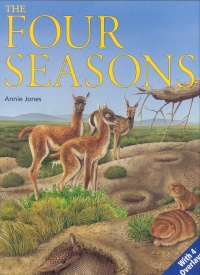| ________________
CM . . .
. Volume XIII Number 2 . . . .September 15, 2006
excerpt:
In a brightly coloured format with four cleverly designed overlays, this book shows the seasonal changes that a variety of plants and animals undergo. Beginning with an explanation for the four distinct seasons that occur in temperate parts of the world, the book offers definitions of weather and climate, solstice and equinox, and briefly discusses possible reasons for climate change and particular weather events. A detailed account of changes through the seasons is shown using an oak tree, examples of animal adaptations, and frog and monarch metamorphoses. Each overlay illustration introduces one seasonal change which is supported by several pages of specific examples. "Winter to Spring" describes awakening life in the Himalayan Mountains, followed by a selection of ways creatures around the world behave in Spring: male rabbits fight for mates, humpback whales perform courtship dances, and male bowerbirds collect decorations to attract a female. The book continues in this pattern with information on nesting, raising young, pollination, migration and hibernation. The illustrations are clear, well-labelled and generously distributed throughout the book. In most cases, global location is made clear for each species used as an example as the illustrations on a single page generally show a mixture of habitats. The overlay depicting Fall to Winter, however, has some labelling problems which may be confusing to North American children using this book. Discrepancies, such as a moose listed as an elk, a great horned owl referred to by its Latin name (Virginian owl), and a wolverine given its alternate name 'glutton,' are understandable as the book is a European publication. However, a Stellers jay is misnamed Blue Jay, and the 'skunk' that rests on a tree branch looks suspiciously like a weasel. The American sparrow hawk is wrongly labelled; now called a Kestrel, it looks nothing like the bird pictured here, nor does the crossbill shown all in brown. Highly Recommended. A freelance writer living in BC, Gillian Richardson is a former teacher-librarian.
To comment
on this title or this review, send mail to cm@umanitoba.ca.
Copyright © the Manitoba Library Association. Reproduction for personal
use is permitted only if this copyright notice is maintained. Any
other reproduction is prohibited without permission.
NEXT REVIEW |
TABLE OF CONTENTS FOR THIS ISSUE
- September 15, 2006.
AUTHORS |
TITLES |
MEDIA REVIEWS |
PROFILES |
BACK ISSUES |
SEARCH |
CMARCHIVE |
HOME |
